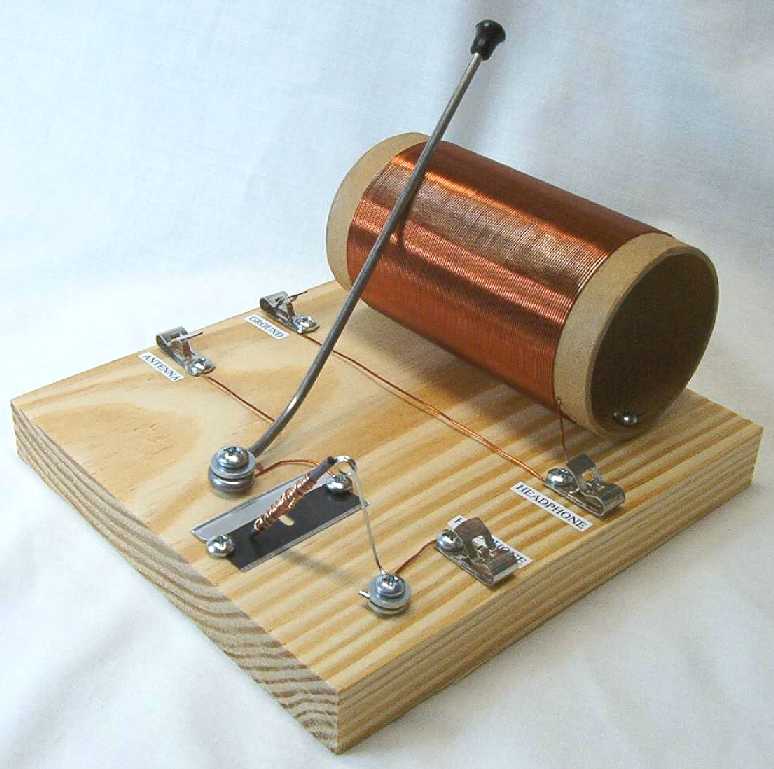

A number of our customers have expressed interest in learning about the simple
little razor blade radios that were built by American soldiers to use in their
foxholes on the battle fields of Europe and the Pacific during World War II.
These radios were essentially crystal sets that used blue razor blades for
detectors because crystals were almost impossible to obtain under the
conditions the G.I.s faced in those days. In the early 1940s, tube type
portable radios were fairly large and used short-lived, expensive batteries
that would have been hard to find in the field. Also, the Germans had
sensitive, radio direction finders that could pick up the local oscillators of
superheterodyne portable receivers. They could use these devices to "home in"
on the locations of the Allied emplacements in order to direct artillery and
aircraft fire. Because of this, it was forbidden to use portable superhets on
the front.
Still, the G.I.s had the desire to listen to news, entertainment, and the
"all-important" baseball scores, along with other sports. Battles did not rage
constantly and sometimes there were many hours and even days when they had to
sit in their foxholes and wait out the boredom. Most locations were close
enough to radio stations to receive them with simple sets.
Many of the G.I.s were radio hobbyists before the war and they had the
knowledge to make simple radios out of junk they found around them. Many of
them knew that materials other than crystals could be used to detect radio
waves. Headsets, wire, screws, and washers could be scrounged off of blown-up
vehicles. Pieces of board came from ammo and supply boxes. Toilet paper tubes
were usually available for use as coil forms and it was easy to find pencils
and safety pins. The word got around through the "grape vine" and many soldiers
made these radios even if they didn't understand how they worked.
The Nazi Propaganda Ministry, oversaw the operation of powerful broadcast
stations that targeted the U.S. Forces with American Swing music, such as the
popular Glenn Miller, and of course, there was the infamous Axis Sally. The
music was good on these stations and it wasn't hard to ignore the Nazi
propaganda. If one were really lucky, he would be able to get the U.S. Armed
Forces Radio Service. This network carried many popular shows, news, sports,
and music from back home - and in English to boot!
Several people wrote in to QST magazine about foxhole radios during World War
II. Among those was young Lieutenant Paul M. Cornell, W8EFW, who wrote of a
design he used in the Pacific in 1945. It was one of the first such articles
that mentioned using a pencil lead for a contact. This Borden Radio Company kit
is named after him in appreciation for his article in the September, 1945 issue
of QST Magazine.
High quality parts are used throughout. The pre-drilled base board is made from
clear pine that is not unlike the wood from ammo boxes and "C" Ration crates
the G.I.s could get in the battlefield. The pre-punched coil form is made from
heavy cardboard shipping tubing that gives the appearance of the G.I.s toilet
paper tubes, but is much stronger and will stand up to many years of use. A
solid steel rod is used for the tuning slider. This is similar to the wire used
in WW-II to bind ammo crates together. A black flaired knob is used for moving
the tuning rod. The PAL Single Edged Blue Razor Blade detector is just like
the blades that many soldiers used for their radios. Nickel plated brass
fahnestock clips are used for the antenna, ground, and headset connections. A
sensitive ceramic earphone is included with the kit.
All parts, screws, washers, sandpaper, and wire are included in this fine
quality kit. This is a great kit that a kid of any age can build and learn
about the simple radios the soldiers built so long ago. A brief history
explains the facts about how these radios came about and how they were used by
the G.I.s in World War II. The easy-to-understand instructions were designed
for beginners. No soldering is required. Nothing else to buy except an outside
antenna kit that is available from Borden Radio Company for $19.95. Soldering
is required. This radio also performs exceptionally well with the Radio Shack
Speaker Amplifier we sell for $14.99. The Radio Shack Speaker Amplifier
requires an adapter cable we sell for $4.95.
Complete kit including all parts and easy to follow instructions:
Source: http://www.xtalman.com/kits.html
|